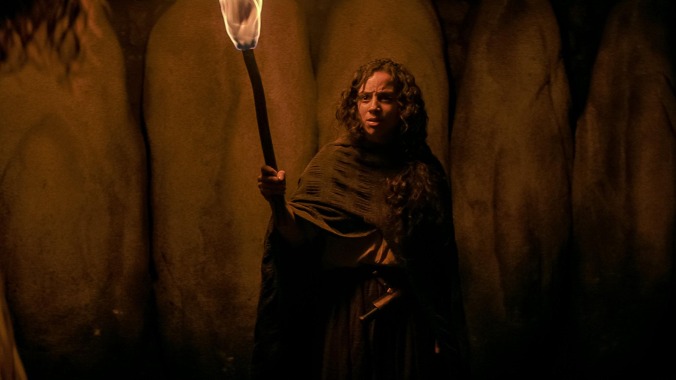Following stories set in a 1994 of post-millennial typefaces and a 1978 of teenagers slinging Austin Powers slang, Fear Street flashes back to an earlier age. Like, much earlier: 1666 is set in the mid-17th century, when the troubled Midwestern town of Shadyside was still a colonial settlement. This blast to the distant past does mitigate the franchise’s weakness for blatant pop-culture anachronisms (there are no slightly premature jukebox music cues, just a generic classical whine of strings) but not its general historical imprecision or implausibility. Anyone expecting the verisimilitude of The Witch has been watching a different trilogy; the vision of the 1600s presented here is closer to a Ren faire production put on by modern theater kids on summer break, uttering the occasional “thou” and “twas” in their shaky Irish accents.
If 1978 was essentially a feature-length flashback, 1666 is like one of those sitcom episodes where a character bumps their head and wakes up in another time period, all their costars cast in different roles. It’s the Back To The Future Part III of the Fear Street series! Previously seen searching for a way to break the curse possessing teenage girlfriend Sam (Olivia Scott Welch), riot grrrl Deena (Kiana Madeira) goes on a vision quest, her consciousness transported from Bill Clinton’s America to Mary Fisher’s. Here, Madeira takes over the role of Sarah Fier, legendary witch of Shadyside lore, while the ensemble cast of the other Fear Street movies do their own double duty as new characters—Benjamin Flores Jr. playing another kid brother, Ashley Zukerman playing an ancestor of the town sheriff he portrayed in 1994, and Welch stepping in as Hannah, the pastor’s daughter locked in a forbidden romance with Sarah. Their love story, mirroring Deena and Sam’s, is the first clue that the tales of Fier’s reign of terror may be more tall than strictly factual.
That Hannah’s surname is Miller should hint at where 1666 is headed, a couple decades before Salem got there. Yes, this is a familiar tale of small-town intolerance, scapegoating, and hysteria, though the timeless condemnation of satanic panic is complicated, maybe even muddled by the fact that dark forces are terrorizing the town, spoiling all its produce and—in the most gruesome of the set pieces—turning the local holy man into an eye-gouging youth minister from hell. (Not to put too fine of a point on it, but it’s hard to issue a convincing condemnation of witch hunts when your story concerns a community actually ravaged by witchcraft.) There’s nothing especially “fun” about this hour-long origin story of evil; while the other Fear Street films flirted with the half-comic thrills of slasher cinema (albeit clumsily), Part Three is a much grimmer affair—more Crucible riff than cheeky video-store throwback.
Yet for anyone who’s stuck with this franchise from the start (which it to say, for the last three weeks), there’s a suitable payoff in how 1666 ties up the dangling loose ends of the overarching narrative and lays out the true nature of what’s been turning this town into a maniac’s playground for centuries. Until now, the mythology of Fear Street felt like tedious exposition—the mere connective tissue between unsteady stabs (har har) at reviving the Jason/Ghostface school of horror. Here, against all odds, the backstory teased by 1994 and 1978 becomes the true source of interest, in part because Janiak and company find a reasonably pointed way to subvert the expectations set by those movies. It would be unfair to get specific, so let’s just say that there’s a shrewd political dimension to Fear Street’s twists—an understanding of America as a nation where some prosper at the expense of others, building their empires on inheritance and the suffering of those on the other side of the tracks.
Eventually, 1666 comes full circle, returning to the ’90s (and to the shopping-mall setting of the saga’s opening sequence) for a destroy-all-slashers finale, bathed in giallo-rave lighting and set to a couple more painfully obvious needle drops. It’s an entertaining climax that leans into the appeal and the limitations of this three-part nostalgia trip. Watching the final chapter, it’s hard to believe that the Fear Street movies were originally conceived with a traditional theatrical release strategy in mind; everything about them, from their “to be continued…” cliffhanger structure to their slickly televisual aesthetic, suggests something designed for episodic consumption—basically a streaming series, in other words. To that end, 1666 offers about the best you could expect from it: a modestly rewarding resolution, like a finale that makes you glad you finished up the season but not convinced you’ll tune in for the next one.


